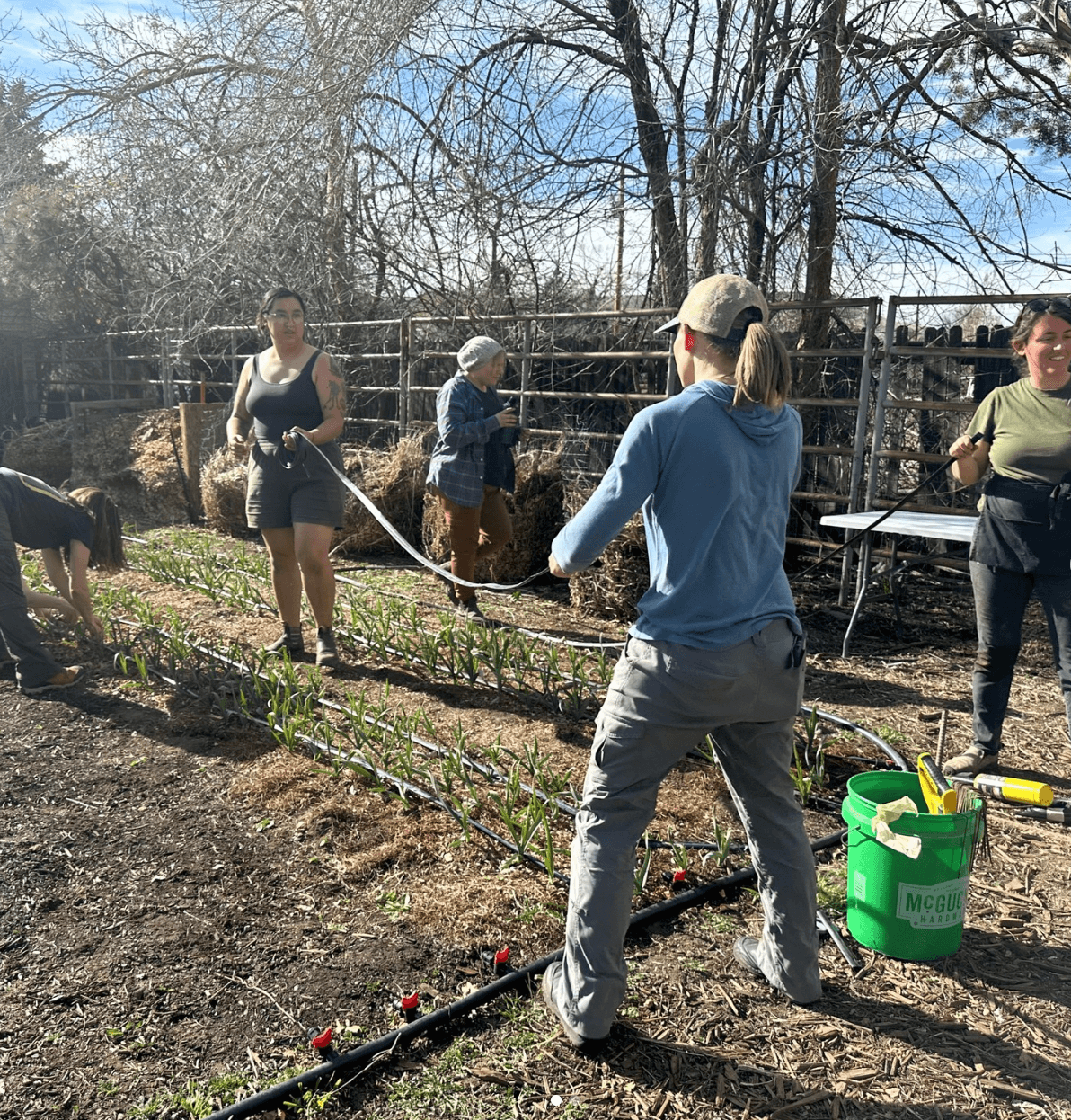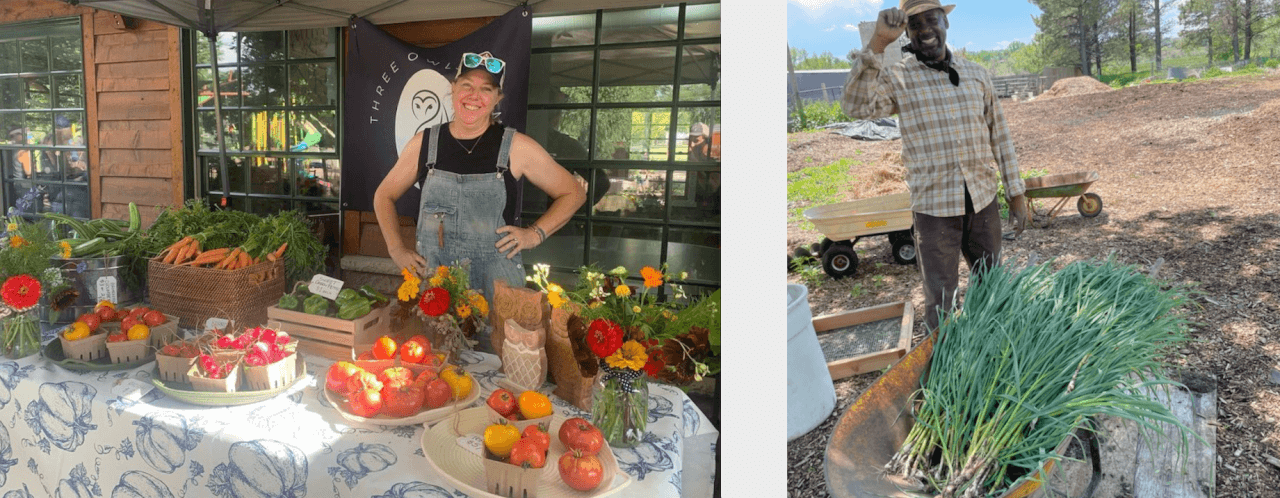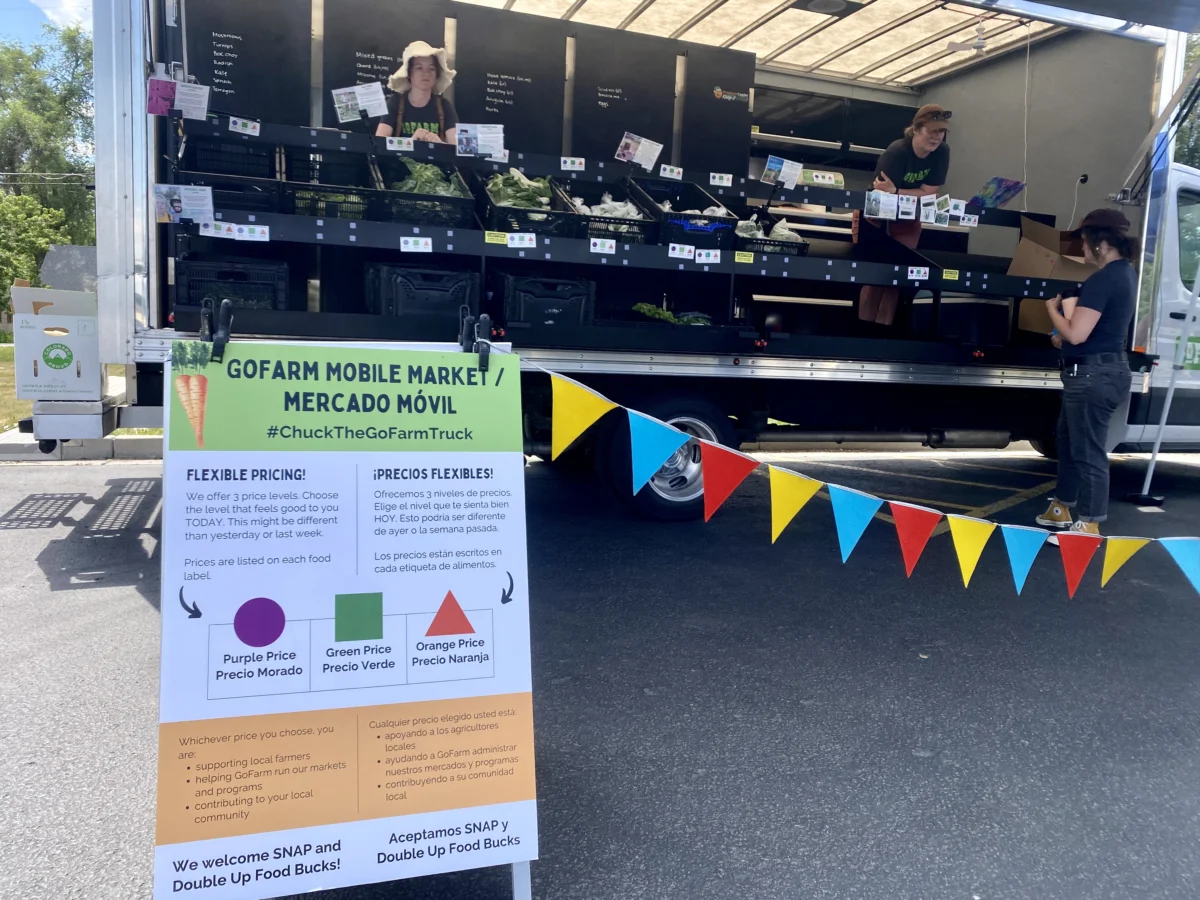This story was originally published by Reasons to be Cheerful
This story was originally published by Modern Farmer.
Throughout the summer in the Golden, Colorado, area, you might see a big box truck full of local fresh vegetables hosting a pay-what-you can farmer’s market. Affectionately called Chuck, GoFarm’s mobile market truck travels to low-income neighborhoods, schools, retirement homes, mobile home communities and more. It offers local produce that GoFarm sources from 80 to 90 farms every season, including small-scale urban farms, large family-owned farms and beginning farmers going through their incubator program.
“Our vision is a strong, resilient, environmentally sustainable and equitable local food system,” says Virginia Ortiz, GoFarms executive director.
Ortiz sees GoFarm’s role as a hub that takes care of the logistics of supporting small farms and feeding the community.
Building community partnerships is a crucial element, and GoFarm works with other food access organizations such as Hunger Free Golden and JeffCo Food Policy Council to reach more people and create a broader base of resources.
Founded in 2014, GoFarm started with its local food share program (essentially a CSA curated from multiple farms). More than a decade later, it has become an organization that trains and develops beginning farmers and creatively tackles the problem of how to get affordable, fresh food to the community. As a nonprofit, it is able to fundraise for grants and donations to support its programming and supplement that with revenue generated through produce sales.
GoFarm’s incubator farmer program gives beginning farmers access to a quarter acre of land for the two-year duration of the program. The farmers receive all the training they need to plan, plant and manage a farm — regardless of their background.

“The average age of current farmers is 55 to 59, and we know that, over the next 10 years, half of current farmers are going to retire, which means that we need to develop a new base,” says Ortiz. But she points out that there is a “tremendous need” for agricultural education.
“Part of our goal is to change the paradigm of farm ownership. Currently, in Colorado, there are approximately 34,000 farms and only one percent are owned by people of color. Yet, 95 to 98 percent of farm workers are people of color, primarily Latinos,” says Ortiz, who shares that she comes from a long line of farmers and farm workers. She says she is proud that, in the farmer development program, 50 percent of participants are people of color, 65 percent are women and 40 percent self-identify as LGBTQ+.
Crushed by negative news?
Sign up for the Reasons to be Cheerful newsletter.
Moses Smith of Full Fillment Farms was an engineer who had gardened before taking GoFarm’s 20-week course and joining the incubator program. “The important thing was the Whole Farm Planning course that really focused on what it takes to actually grow food,” says Smith.
“One of the biggest benefits is that they not only provide us with land access, which is very hard as a starting farmer, but they also give us a market avenue,” says Ann Poteet of Three Owls Farm. As incubator farmers are establishing their businesses and learning how to generate their own markets, they sell produce back to GoFarm.
GoFarm’s local food share program feeds anywhere from 500 to 800 members each summer. Members come every week to pick up their share from a few different locations where GoFarm has refrigerated shipping containers to store food after it’s delivered by farmers. Plus, GoFarm takes Chuck out and about in Denver and Jefferson counties every week to ensure they can reach underserved populations that are challenged with food insecurity, disability, transportation and other barriers, such as the communities living in designated food deserts in south Golden.

“I have an interest in nutritional insecurity,” says Poteet, who was a nurse practitioner before starting her farm.
“It’s been really inspiring,” says Smith about being able to see his food nourish the community through GoFarm.
But farmer’s market prices can be high, as producers need to be fairly compensated for their labor and costs. “Customers were clear to us that having access to healthy food was critical to them and affordability was a barrier,” says Ortiz. So, in 2022, GoFarm found the funding it needed to implement a new solution that goes even further to improve accessibility for the 2,600+ households it reaches.
Customers at its mobile markets can choose from one of three price tiers to shop that day, depending on their needs. For example, bags of mixed greens have three prices listed: $2 (purple), $3 (green) and $4 (orange). And the microgreens are even cheaper, at $1, $2 or $3 for a box. Pasture-raised eggs can be $3, $5 or $7 a carton.
“You are what you eat,” says Kaylee Clinton, a first-time GoFarm mobile market shopper. “I just feel better about myself when I eat fresher.” As inflation has hit grocery stores, she says that SNAP has helped make food more affordable and she appreciates that GoFarm lets shoppers pick their price point. “I really love it. I think it’s great for everybody.”
“Typically, I either buy green or orange. I like buying orange when I can. It’s good to have the flexible pricing,” says Ed Gazvoda, who has been shopping at GoFarm for years. “I want to live a good, long, healthy life, so it’s a personal thing, but I just love the food.”

Jess Soulis, director of the Community Food Access program, highlights that accepting SNAP’s DoubleUp Food Bucks (DUFB) — where shoppers essentially get a 50-percent discount — is just one way to make food more affordable. The group also partners with WIC’s Farmers Market Nutrition Program, where participants get a credit to shop. Through its market locations at Littleton Advent Hospital and Juanita Nolasco Senior Residences, the program offers shoppers $10 worth of produce for free. SNAP/DUFB account for 13 percent of its mobile market sales, but all of these incentives combined are closer to two-thirds.
The vision continues to grow. The only limitation? “Infrastructure,” says Ortiz. GoFarm is currently seeking out refrigerated warehouse space along the I-70 corridor between Golden and the Denver neighborhood of Montbello.
“That area is important because we need to make it accessible to farmers along the Front Range,” says Ortiz. “With that refrigerated warehouse space, we could easily source from more farmers, distribute more food and serve more communities.”
Modern Farmer is a nonprofit initiative dedicated to raising awareness and catalyzing action at the intersection of food, agriculture, and society. Read more at Modern Farmer.
The post A Vibrant Local Food System Grows in Colorado appeared first on Reasons to be Cheerful.




